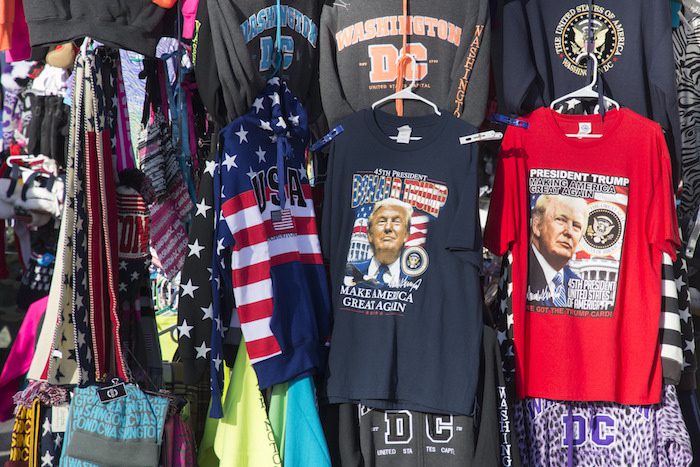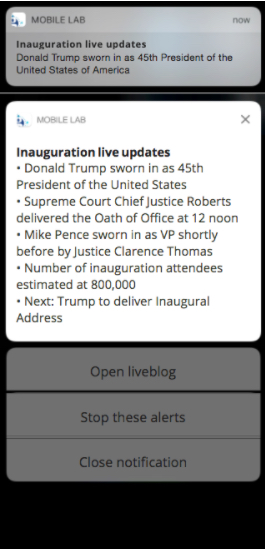
As Donald Trump takes the oath of office Friday and parades down Pennsylvania Avenue, The Guardian’s Mobile Innovation Lab will be running four separate experiments around push notifications and live coverage.
We've been cooking up four new features (on three platforms) for you to try on Friday https://t.co/cf5SKPy2ia
— Madeline Welsh (@madelinebwelsh) January 18, 2017
 Using iOS 10’s expanded push notification capabilities, the Lab plans to livestream the inauguration inside a push alert. To use the feature, users will have to download a standalone Mobile Innovation Lab app. Once they get a notification, they can tap on it and watch the swearing in and other pageantry right on their lock screens.
Using iOS 10’s expanded push notification capabilities, the Lab plans to livestream the inauguration inside a push alert. To use the feature, users will have to download a standalone Mobile Innovation Lab app. Once they get a notification, they can tap on it and watch the swearing in and other pageantry right on their lock screens.
“So far as we know, this is the first time anyone has used notifications this way, and we’re excited to try it,” the Lab announcement reads.
The Lab also plans to use its app to send notifications with an automatically updated liveblog. “The notification will update automatically with the highlights of what happened most recently as well as information about what’s to come,” the Lab said. The in-notification liveblog will also be available to Android users through Chrome web notifications.
 The Lab is also introducing something called Shifting Lenses, an in-app feature that will allow “you to swipe left and right between two views to get the latest on what’s happening in the official ceremony and also around the streets of Washington.” Shifting Lenses will be run through the Mobile Innovation Lab’s app, and it’ll be launching later in the afternoon after some of the events have wrapped up.
The Lab is also introducing something called Shifting Lenses, an in-app feature that will allow “you to swipe left and right between two views to get the latest on what’s happening in the official ceremony and also around the streets of Washington.” Shifting Lenses will be run through the Mobile Innovation Lab’s app, and it’ll be launching later in the afternoon after some of the events have wrapped up.
It’s always a challenge for news organizations to get users to download new apps; The Guardian sent a push alert through its main iOS app on Thursday night to encourage its users to try out the Mobile Lab’s app and experiments. It also published a story this week on its own site about the experiments. Having a separate app should make it easier for experimental (and, by their nature, potentially buggy) features to reach users than working through the main Guardian app.
 The fourth component of the Lab’s inauguration coverage will be the ability for users reading The Guardian’s liveblogs on mobile Safari or Chrome to watch video and read a liveblog at the same time, a feature a number of sites have had on desktop for some time. “The video will minimize and pin to the bottom right of the screen so you can stay up to date with the events as they happen in the video and also read the blog to catch up on what you may have missed,” the Lab said.
The fourth component of the Lab’s inauguration coverage will be the ability for users reading The Guardian’s liveblogs on mobile Safari or Chrome to watch video and read a liveblog at the same time, a feature a number of sites have had on desktop for some time. “The video will minimize and pin to the bottom right of the screen so you can stay up to date with the events as they happen in the video and also read the blog to catch up on what you may have missed,” the Lab said.

Inauguration Day 2009 was also a big day for Twitter — there were four times the usual number of tweets sent during Obama’s swearing in — but in a blog post, Twitter’s Biz Stone noted that overall, “Twitter sailed smoothly through the inauguration but at the peak, some folks did experience a 2-5 minute delay receiving updates.”
January 21, 2009 — the day after Obama’s inauguration — was at the time the third-highest-traffic day in New York Times history. The paper had about 49 million pageviews, 25 percent more than on Inauguration Day itself. (For comparison’s sake, Nieman Lab, then three months old, got 348 pageviews on Inauguration Day 2009.) The big draw (prepare for a timewarp): slideshows. The Times said slideshows received 11 million pageviews that day. As we reported at the time:One slideshow of the inaugural balls generated 2.7 million pageviews alone that day. A slideshow of the ceremony garnered 900,000, and another one took in 800,000. Other multimedia took in an additional 5 million pageviews.
During the week of the 2013 inauguration, the Times discontinued its Election 2012 mobile app, which it launched in December 2011 to showcase its political coverage on iOS. Fiona Spruill, who was then the Times’ emerging platforms editor, joked with the Lab that by 2016 “we’re all going to be wearing all of our political coverage,” noting that mobile would become more prevalent in future coverage.
“It’s obvious that mobile was a huge part of this election,” Spruill said. “The next election, many news organizations probably will have crossed that 50 percent threshold where they’re getting more traffic from phones and tablets. So I imagine it would be quite a bit different how many news organizations focus on their election coverage. It’s hard to say exactly what format that will take.”